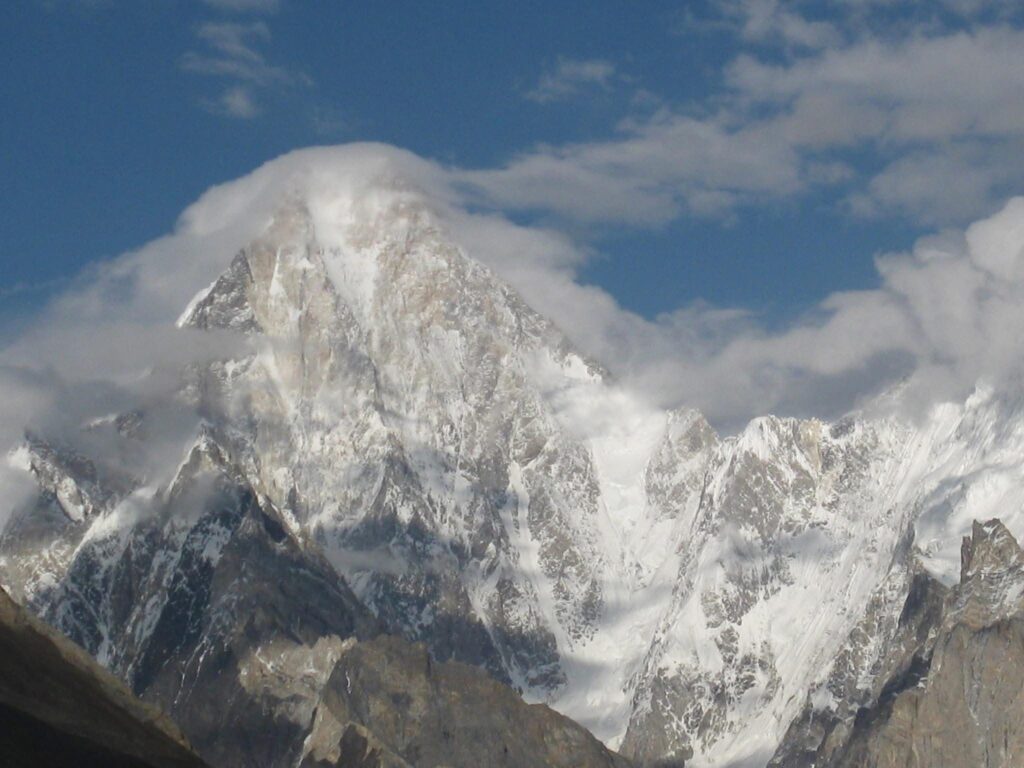Gasherbrum IV: A Climber’s Perspective

At 7,925 meters (26,001 feet), Gasherbrum IV, located in the Karakoram Range of Pakistan’s Gilgit-Baltistan region, may not be the tallest mountain in the world, but its imposing presence, technical challenges, and storied climbing history make it one of the most revered peaks among mountaineers.
Nicknamed the “Shining Wall” due to its breathtaking west face, this mountain captivates adventurers with a desire to push the limits of human achievement.
Whether you aspire to climb Gasherbrum IV or are simply fascinated by the world of modern Alpinism, this article offers a detailed exploration of the mountain’s unique attributes, its climbing history, and what makes it such a monumental challenge.
Why Gasherbrum IV Demands Attention
Gasherbrum IV grabs the climbing community’s attention for tangible and symbolic reasons. Despite being the 17th highest peak in the world, its technical difficulty and notorious weather conditions make it one of the most challenging summits to conquer.
The name “Gasherbrum” translates to “beautiful mountain” in the Balti language, and the mountain certainly lives up to its name.
Its intimidating 2,500-meter vertical wall’s west face epitomizes the essence of high-stakes mountaineering, combining unforgiving terrain with severe physical and mental demands. This striking facade has become a proving ground for some of the world’s most accomplished climbers.
Yet, it’s not just the spectacular geography that intrigues climbers—the mountain also symbolizes perseverance, innovation, and a deep respect for nature’s force and beauty.
A Peek Into Gasherbrum IV’s Climbing History
The climbing history of Gasherbrum IV reads like a chronicle of sheer determination and courage. Here’s a glimpse into some of its most notable expeditions:
1958 – The First Summit
An Italian team led by Riccardo Cassin achieved the first ascent of Gasherbrum IV. Walter Bonatti and Carlo Mauri summited via the Northeast Ridge, overcoming the technical challenges of the pinnacled ridge to reach the main summit.
This marked a historic achievement in mountaineering as the climbers conquered uncharted and perilous terrain.
1985 – The Legendary West Face Attempt
Wojciech Kurtyka and Robert Schauer’s alpine-style climb of the west face remains one of the boldest achievements in climbing history.
Although they stopped short at the north summit due to extreme exhaustion and lack of resources, their feat was described as the “most remarkable alpine-style ascent of the 20th century,” underlining Gasherbrum IV’s immense difficulty.
1997 – First Successful West Face Summit
A Korean team led by Bang Jung-ho made the first complete ascent of the west face, reaching the summit after a grueling expedition via the central spur. The climb involved technical pitches rated as high as 5.10 A3, highlighting the mountain’s relentless demands.
Recent Tragedies and Attempts
Despite technical advancements, the mountain continues to claim lives and test climbers’ limits. From failed attempts on the East Face to avalanches and accidents on the West Face, Gasherbrum IV serves as a stark reminder of nature’s unpredictability.
What Makes It a Climatic Challenge?
What causes seasoned climbers to deem Gasherbrum IV more difficult than many 8,000-meter peaks?
1. The Technical Terrain
Gasherbrum IV’s varied ridges and faces—especially the West Face—feature a combination of steep rock, ice, and mixed climbing that demands mastery of advanced alpine techniques. Climbers face technical pitches, knife-edge ridges, and challenging traverses, making success contingent on both skill and experience.
2. Unpredictable Weather
The Karakoram Range is infamous for its volatile weather. At Gasherbrum IV, climbers frequently face sudden storms, extreme cold, and heavy snowfall that can halt progress for days or even weeks. Avalanches are a constant threat, adding an extra layer of danger.
3. High Altitude and Isolation
At nearly 8,000 meters, the scarcity of oxygen amplifies physical and mental strain. Unlike Everest, with its commercial guiding infrastructure, Gasherbrum IV offers no such comforts. Climbers are entirely self-reliant, heightening the risks and allure of the challenge.
4. The Psychological Test
Finally, the mountain presents an unparalleled mental challenge. Long hours spent navigating exposed ridges, harsh conditions, and isolation test a climber’s determination and resilience.
Why Climbers Revere Gasherbrum IV
The mountain’s magnetism lies in what it represents—a perfect confluence of beauty and danger, offering a deeply personal challenge for every climber.
Gasherbrum IV’s Shining Wall goes beyond physical achievement for mountaineers like Wojciech Kurtyka. It symbolizes a spiritual conquest, a dance with the unknown.
Each expedition to the summit is fueled by the determination to achieve and the humility to respect the mountain’s power. Gasherbrum IV’s legacy embodies the essence of mountaineering as more than a sport—it is a mindset, a calling, and a passion.
Conquering Gasherbrum IV Today
While this mountain remains accessible only to the most experienced climbers, advances in gear and climbing techniques are making modern ascents safer and more strategic.
Climbers now use state-of-the-art equipment like ultra-light shelters, advanced ice tools, and precision-engineered ropes to increase their chances of making it to the top.
At the same time, the spirit of mountaineering has remained unchanged—climbing Gasherbrum IV is still about grit, perseverance, and reverence for the wild.
Final Thoughts
For climbers and enthusiasts alike, Gasherbrum IV is a testament to human determination and the spirit of exploration. It stands as one of the last great challenges of alpinism, a peak where skill, courage, and humility come together.
While few may reach the summit, the lessons of Gasherbrum IV extend far beyond its icy ridges—reminding us all of the value of persistence, respect for nature, and the pursuit of a dream.
Are you ready to take the next step in your mountaineering adventures? Delve deeper into the history and stories of mountaineering legends or plan your own expedition. And remember, the mountains will always be waiting.
